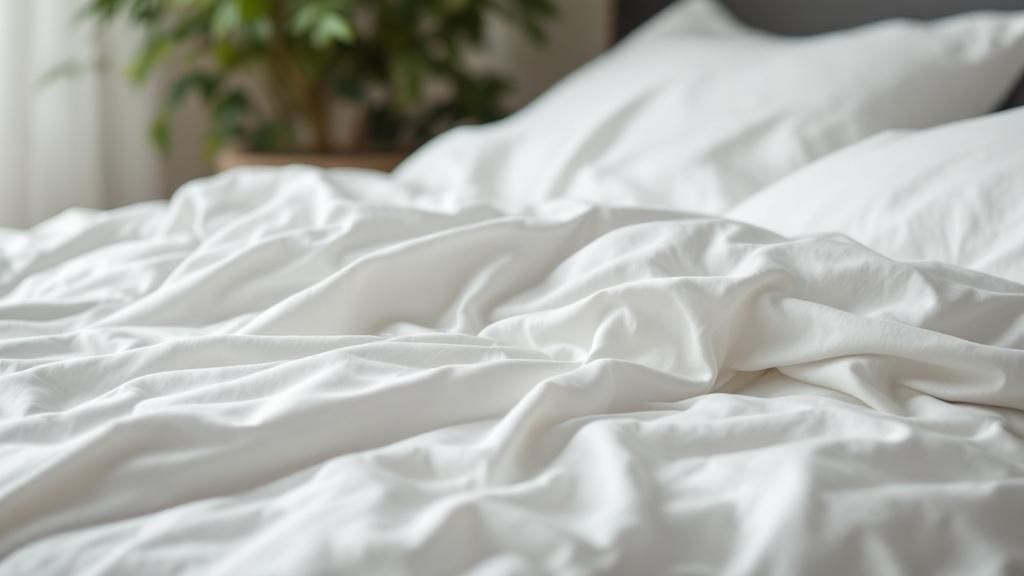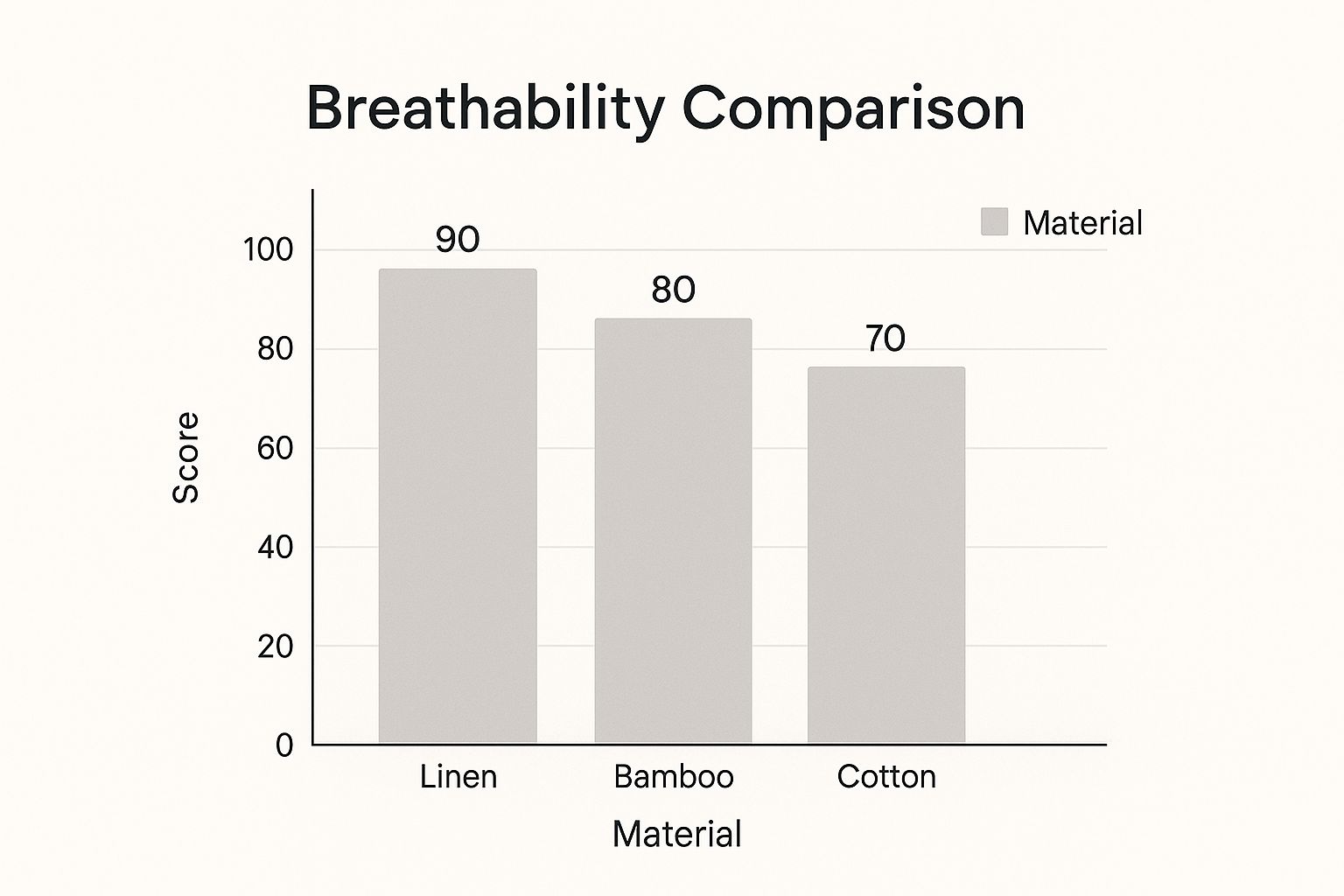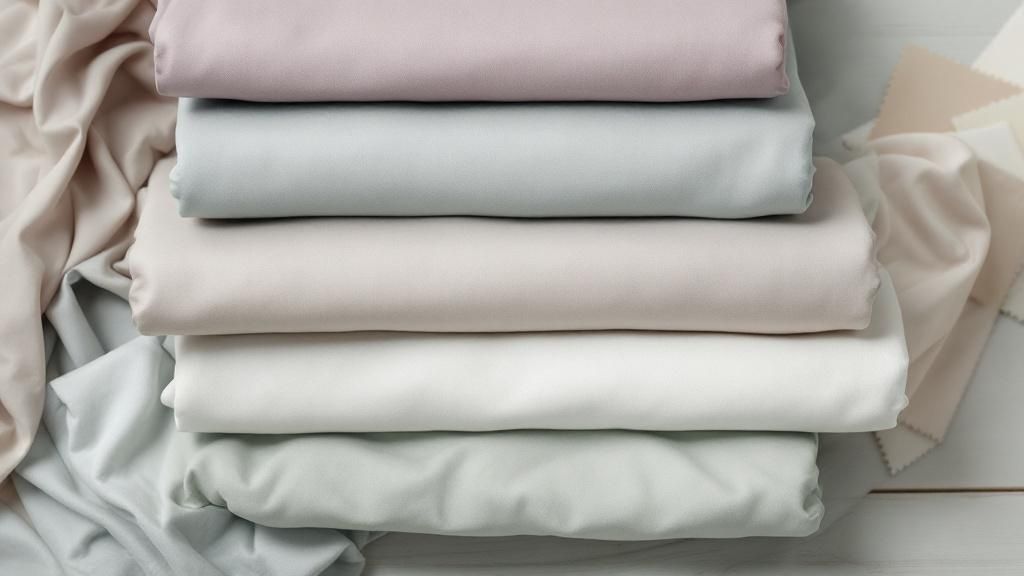If you're on the hunt for the best breathable bed sheets, your search should start with natural fibers like long-staple cotton and linen. From my experience, these materials are absolute champions when it comes to wicking away moisture and allowing for fantastic airflow. They're my go-to recommendation for hot sleepers or really anyone who just wants a more comfortable, even-temperature night.
Why Breathable Sheets Are a Sleep Game-Changer

Let’s be real for a moment. Waking up in a pool of your own sweat is a miserable experience and the quickest way to kill a good night's sleep. This is where breathable sheets stop being a simple luxury and become an absolute necessity. Their job is to tackle the two things that cause nighttime overheating: trapped body heat and moisture.
The way they work is pretty straightforward. Fabrics like linen or a crisp percale cotton have a weave that lets air move freely around your body. This constant circulation means the heat you naturally give off has somewhere to go, rather than getting stuck under the covers and turning your bed into a personal sauna.
How This Actually Affects Your Sleep
Think about a common household dilemma: one partner sleeps like a furnace while the other is always reaching for an extra blanket. With standard, non-breathable sheets, the hot sleeper sweats, which creates a damp, clammy feeling that then makes the colder sleeper feel even more chilled. Nobody wins.
Breathable fabrics, on the other hand, completely change the dynamic by managing the "microclimate" of your bed.
- For the hot sleeper: Moisture is wicked away from the skin and evaporates quickly, which has a natural cooling effect.
- For the cold sleeper: The bed stays dry. A dry environment is much better at maintaining a stable, comfortable temperature.
I always tell people that investing in the right sheets is a direct investment in your sleep quality. You're creating an environment that works with your body's own temperature regulation, not against it, and that's the key to deeper, more restorative rest.
This isn't just a niche concern anymore; it's a massive trend. The global demand for quality bedding is exploding, with the bed sheets market valued at an impressive USD 15.2 billion in 2024. It's even projected to hit USD 23.8 billion by 2033, and a huge part of that growth comes from people like you prioritizing sleep comfort.
Cotton sheets are leading the pack, accounting for over 45% of the market's revenue simply because they offer proven breathability and all-around comfort. If you're interested, you can dig deeper into the latest bedding market trends.
Choosing the Right Material for Your Sleep Style
Walking through the bedding aisle can feel a bit like a pop quiz on fabrics. But don't worry, finding the right sheets isn't that complicated. The best breathable bed sheets come in a handful of go-to materials, and the right one for you really just depends on your personal sleep style. Are you a human furnace who kicks off the covers, or do you just crave that light, airy feeling?
Let’s talk about the top contenders.
First up is long-staple cotton, especially with a percale weave. If you love the crisp, cool feel of a high-end hotel bed, this is your match. It's built to last and fantastic at promoting airflow. Then there's linen, which is the undisputed champion of that relaxed, slightly rustic vibe. Linen fibers are actually hollow, which makes them incredibly effective at pulling heat and moisture away from your skin.
And finally, you have the newer, ultra-popular fabrics made from bamboo or eucalyptus, like Tencel™ lyocell. These are famous for their silky, almost cool-to-the-touch sensation. If you're curious about this option, it's worth understanding what Tencel fabric feels like to see if its unique properties are what you’ve been looking for.
Breathable Bed Sheet Material Comparison
To make things even clearer, let's put these materials head-to-head. This table breaks down the key features of popular breathable sheet materials to help you choose the best option for your sleep preferences.
| Material | Feel | Breathability | Moisture-Wicking | Price Point |
|---|---|---|---|---|
| Percale Cotton | Crisp, cool, and matte | Excellent | Good | Mid-range |
| Linen | Relaxed, textured, and airy | Superior | Excellent | Higher-end |
| Bamboo/Tencel | Silky, smooth, and cool | Very Good | Superior | Mid to High |
As you can see, there’s no single "best" material—just the one that’s best for you. A hot sleeper who sweats a lot might lean toward the superior moisture-wicking of Tencel or linen. On the other hand, someone who just wants better airflow without the silky feel might fall in love with the classic crispness of percale.
Pro Tip: When you're shopping, keep an eye out for the OEKO-TEX Standard 100 certification on the label. This is a quick way to know the fabric has been tested for harmful substances, so you can be sure your new sheets are safe for you and your family. It's a simple gut-check for quality and health.
The image below gives you a great visual on how these materials stack up when it comes to pure breathability.

While all three are fantastic options, linen often takes the top spot for maximum airflow.
This growing demand for high-performance, natural fibers is making a real impact. The U.S. bedsheets market was valued at an impressive USD 7.75 billion in 2024 and is projected to hit USD 11.55 billion by 2032. A huge part of that growth comes from shoppers seeking out eco-friendly materials like organic cotton and bamboo.
Bamboo, in particular, has exploded in popularity because it offers a one-two punch of incredible softness and excellent temperature regulation. If that sounds like a dream, you might want to explore the many reasons bamboo sheets are better for getting a truly comfortable night's sleep.
What Really Matters More Than Thread Count

For years, we’ve been told that a higher thread count equals better, more luxurious sheets. It’s a marketing tactic that’s worked wonders, sending us on a quest for sheets with counts of 800, 1,000, or even higher. But if you're a hot sleeper searching for truly breathable bedding, that number can be incredibly misleading.
The real secret to a cool night’s sleep lies not in the thread count, but in the fabric's weave. Think of weave as the specific pattern—how the individual threads are interlaced to create the final fabric. This construction is what ultimately determines airflow and how cool the material feels against your skin.
When it comes to cotton, two weaves dominate the conversation: percale and sateen. They couldn't be more different in feel and function, especially for those of us who run warm.
Percale vs. Sateen: The Airflow Battle
A percale weave is constructed with a simple, one-thread-over, one-thread-under pattern. It’s a classic grid-like structure that creates a light, crisp fabric with plenty of tiny pores for air to pass through. This is what gives percale its signature cool-to-the-touch feeling, making it an absolute game-changer for hot sleepers.
Sateen weave, on the other hand, uses a more complex pattern—typically one thread under and four threads over. This technique exposes more of the thread's surface, giving the fabric that silky, lustrous sheen many people associate with luxury. The downside? This tighter, denser structure traps heat and seriously limits airflow, which can be a nightmare if you're prone to overheating.
While a sateen sheet might feel buttery soft when you first slip into bed, it’s the airy percale sheet that will actually keep you comfortable all night. When genuine breathability is the goal, the weave always wins.
So where does thread count fit in? It’s not totally irrelevant, but there's a definite sweet spot. For percale sheets, a thread count between 200 and 400 is the ideal range. This provides a perfect balance of softness and durability without sacrificing that all-important breathability.
Anything much higher often means the manufacturer has manipulated the count by using thinner, weaker threads, which can actually clog the weave and block air from moving freely.
If you want to go deeper, it's worth learning what is the best thread count for sheets to see why other factors often matter more. The main takeaway is simple: for a cooler sleep, always prioritize the material and weave over an inflated thread count.
How to Keep Your Sheets Cool and Comfortable for Years
So, you've invested in a great set of breathable bed sheets. Smart move. Now, let's talk about keeping them that way, because the little things you do (or don't do) in the laundry room make a huge difference in how they perform night after night.
One of the most common mistakes I see is using conventional liquid fabric softeners or dryer sheets. It seems harmless, but these products leave a waxy film on the fibers. This residue clogs the fabric's natural pores, completely defeating the purpose of your cooling sheets by trapping heat and moisture.
Washing and Drying Done Right
To keep that "brand new" airy feeling, always wash your sheets in cool or warm water. Skip the hot cycle—high heat is a fast way to damage delicate natural fibers like bamboo, Tencel, or long-staple cotton. Stick with a gentle, pH-neutral detergent to get the job done without being too harsh.
When it's time to dry, you've got a few great options:
- Toss in Some Wool Dryer Balls: These are a game-changer. They act as a natural, chemical-free fabric softener, bouncing around in the dryer to separate your sheets. This simple trick improves airflow, which means faster drying times and less clumping.
- Keep the Heat Low: High heat is the main culprit behind shrinkage and pilling. Always tumble dry on a low or medium setting. Your sheets might take a little longer to dry, but they'll last for years.
- Line Dry if You Can: There's nothing better than line-drying. It's the gentlest method possible and leaves your sheets with an amazing fresh-air scent that you just can't replicate.
You might assume all fabrics eventually wear down, but linen is the fascinating exception. It actually gets softer, more absorbent, and even better at cooling with every single wash. It truly improves with age.
Taking care of your linens isn't just about making them last longer; it's about preserving their performance. There's a reason the global bed linen market soared past USD 23.64 billion in 2021, with breathable materials like cotton dominating 63.4% of sales, as reported by Global Market Insights. People are paying for comfort, and proper care protects that investment.
Following these simple habits will ensure you get your money's worth, enjoying cool and comfortable sleep for a long time. For more tips specifically for these advanced fabrics, check out our guide on maintaining cooling bed sheets.
Your Pre-Purchase Checklist for Perfect Sheets

So, you're just about ready to make a purchase. Hold on for a second. Before you hit that "buy" button, it's worth taking a moment to run through a quick mental checklist. I've found that asking a few key questions upfront can save you from a case of buyer's remorse later.
First things first, get honest about your sleep temperature. Are you someone who constantly battles the heat, throwing off covers all night long? Or do you just need a bit more airflow to feel truly comfortable? Your answer here is crucial. It’s the difference between needing the cooling power of a material like linen versus a lighter, crisper option like percale cotton.
Next, let's talk texture. This is all about what feels good against your skin. Do you dream of that buttery smooth, silky feeling you get from Tencel? Or is your idea of heaven the crisp, clean feel of a high-end hotel sheet? For many, the texture is just as important as how cool the fabric is.
For example, a lot of people are drawn to the uniquely soft and supple feel of bamboo-derived fabrics. If that sounds like something you'd enjoy, it’s worth learning more about what makes bamboo sheets a unique choice.
Final Gut-Check Questions
Ready to click "add to cart"? Ask yourself these last few questions. Think of it as a final gut-check to make sure you're buying with total confidence.
- What's my realistic budget? Quality sheets are absolutely an investment, but that doesn't mean you have to break the bank. There are fantastic, breathable options at nearly every price point.
- How much do I care about sustainability? If eco-friendly production matters to you, keep an eye out for certifications like OEKO-TEX or fabrics made using a closed-loop system.
- What’s the return policy like? Let's be real—sometimes you just have to sleep on a set of sheets to know if they're the one. A flexible return policy is your safety net.
Taking a minute to consider these points means you’re not just buying another set of sheets. You're making a thoughtful decision that will pay off in better, more comfortable sleep for years to come.
Still Have Questions About Breathable Sheets?
Even after getting the rundown on materials and weaves, a few questions might still be swirling around. That’s completely normal. Let's dig into some of the most common things people ask, so you can feel totally confident in your choice.
Are Bamboo Sheets Really Sustainable?
This is a big one, and the honest answer is: it depends. The sustainability of bamboo fabric comes down to how it's made.
When you see fabrics made with a closed-loop lyocell system (like Tencel™), that's the gold standard for eco-friendliness. This method recycles the water and solvents used in production, creating very little waste.
On the other hand, the more common viscose process involves some pretty harsh chemicals and isn't nearly as kind to the planet. If sustainability is high on your list, always check the product description for how the bamboo was processed.
How Can I Tell if Sheets Are Breathable Before Buying?
It can feel like a guessing game, but there are a couple of good clues. First, check the weave. A percale weave is your best bet for airflow. Its simple, crisscross pattern is inherently more open and porous than a tightly woven sateen.
If you happen to be in a store and can touch the sheets, try this little trick: hold a single layer up to a light. The more light that peeks through, the more breathable the fabric will be. It's a simple but surprisingly effective test.
Won't Breathable Sheets Make Me Cold in the Winter?
This is probably the most common myth we hear, but it's a great question. The short answer is a definite no. "Breathable" doesn't actually mean "cold"—it means temperature-regulating.
Think about it this way: these sheets are designed to stop heat from getting trapped, which is what makes you overheat and sweat. By wicking away any moisture, they keep your bed feeling dry and balanced. And a dry bed is a comfortable bed, no matter what the thermometer says outside.
It's helpful to think of them as the perfect base layer. In the colder months, you just add a cozier blanket or a thicker duvet on top. Your breathable sheets will handle the moisture and keep you from getting clammy, while your top layers provide the insulation.
They simply adapt to keep you comfortable, making them a fantastic choice for year-round use.
Ready to feel the difference that true temperature-regulating bedding can make? Discover the silky-soft, eco-friendly comfort of Bamtek's 100% organic bamboo sheets.
Explore the Bamtek Home collection now.










